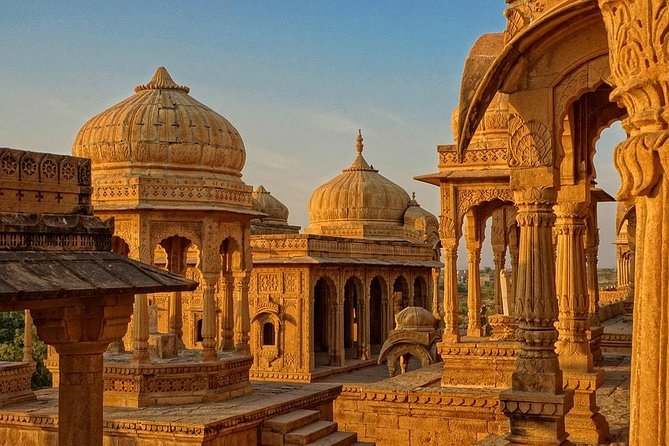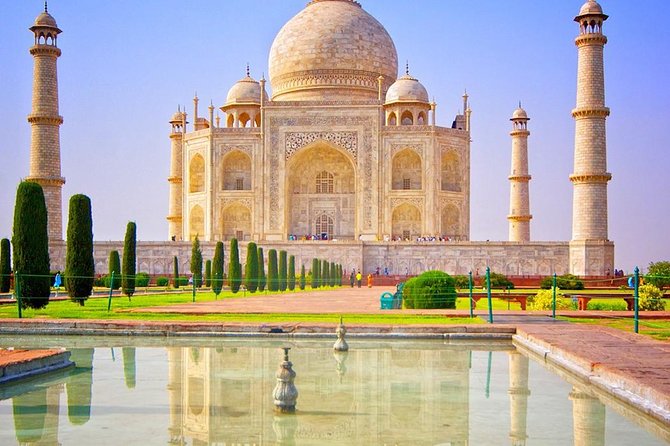New Delhi Trip Overview
Visit a UNESCO World Heritage Site—the Taj Mahal
Avoid crowded public transport with a private car transfer
An English-speaking guide will accompany you in
Agra Stay hydrated—bottled water, juice, and snacks provided
Additional Info
Duration: 2 days
Starts: New Delhi, India
Trip Category: Cultural & Theme Tours >> Cultural Tours
Explore New Delhi Promoted Experiences
What to Expect When Visiting New Delhi, Delhi, India
Visit a UNESCO World Heritage Site—the Taj Mahal
Avoid crowded public transport with a private car transfer
An English-speaking guide will accompany you in
Agra Stay hydrated—bottled water, juice, and snacks provided
Itinerary
Day 1: Delhi Railway Station / Airport –Hotel + Half day Sightseeing
Stop At: Raj Ghat, Mahatma Gandhi Road, New Delhi 110002 India
Raj Ghat is a memorial dedicated to Mahatma Gandhi. Originally it was the name of a historic ghat of Old Delhi (Shahjahanabad) on the banks of Yamuna river. Close to it, and east of Daryaganj was Raj Ghat Gate of the walled city, opening at Raj Ghat on Yamuna River. Later the memorial area was also called Raj ghat. It is a black marble platform that marks the spot of Mahatma Gandhi’s cremation, Antyesti (Antim Sanskar) on 31 January 1948, a day after his assassination. It is left open to the sky while an eternal flame burns perpetually at one end. It is located on the banks of the river Yamuna in Delhi in India on Ring Road officially known as Mahatma Gandhi Road. A stone footpath flanked by lawns leads to the walled enclosure that houses the memorial. All guests must remove their footwear before entering the Raj Ghat walls.
Duration: 30 minutes
Stop At: Jantar Mantar, Sansad Marg Parliament Street, New Delhi 110001 India
Jantar Mantar is located in the modern city of New Delhi. It consists of 13 architectural astronomy instruments. The site is one of five built by Maharaja Jai Singh II of Jaipur, from 1723 onwards, as he was given by Mughal emperor Muhammad Shah the task of revising the calendar and astronomical tables. There is a plaque fixed on one of the structures in the Jantar Mantar observatory in New Delhi that was placed there in 1910 mistakenly dating the construction of the complex to the year 1710. Later research, though, suggests 1724 as the actual year of construction.
Duration: 30 minutes
Stop At: Parliament House, Sansad Marg, New Delhi 110002 India
Parliament House is also known as Sansad Bhawan. It is a magnificent circular colonnaded structure where the representatives of Indian democracy meet. Parliament House is the office of the world’s largest democracy where the future course of the country is discussed and debated. Parliament House was built for the Chamber of Princes, the Council of State and the Legislative Assembly. Today it is the chambers of the Lok Sabha (House of the people), Rajya Sabha (Upper House) and the Library. This mesmerizing circular structure was designed by the two famous architects Sir Edwin Lutyens and Sir Herbert Baker. The Foundation Stone of Parliament House was laid by H.R.H. the Duke of Connaught on 12th February, 1921. It took around six years to complete this building. After its completion in 1927, it was inaugurated by the then Governor-General of India, Lord Irwin on 18th January.
Duration: 30 minutes
Stop At: India Gate, Rajpath Near Connaught Place New Delhi, New Delhi 110001 India
The India Gate, (originally called the All India War Memorial), is a war memorial located astride the Rajpath, on the eastern edge of the ‘ceremonial axis’ of New Delhi, India, formerly called Kingsway. India Gate is a memorial to 82,000 soldiers of the Indian Army who died in the period 1914–21 in the First World War, in France, Flanders, Mesopotamia, Persia, East Africa, Gallipoli and elsewhere in the Near and the Far East, and the Third Anglo-Afghan War. 13,300 servicemen’s names, including some soldiers and officers from the United Kingdom, are inscribed on the gate.The India Gate, even though a war memorial, evokes the architectural style of the triumphal arch like the Arch of Constantine, outside the Colosseum in Rome, and is often compared to the Arc de Triomphe in Paris, and the Gateway of India in Mumbai. It was designed by Sir Edwin Lutyens. In 1971, following the Bangladesh Liberation war, a small simple structure, consisting of a black marble plinth, with a reversed rifle, capped by a war helmet, bounded by four eternal flames, was built beneath the soaring Memorial Archway. This structure, called Amar Jawan Jyoti, or the Flame of the Immortal Soldier, since 1971 has served as India’s Tomb of the Unknown Soldier.
Duration: 30 minutes
Stop At: Janpath Market, Janpath Rd Connaught Place, New Delhi 110001 India
Janpath translated People’s Path, is one of the main roads in New Delhi. It starts out as Radial Road 1 in Connaught Place, adjacent to Palika Bazaar, and runs North-South perpendicular to, and past Rajpath.
Duration: 1 hour
Meals included:
• Breakfast
Accommodation included: Hotel White House, a 3 star Hotel
Day 2: Delhi –Agra Sightseeing (216 Km / 3 ½ hrs)
Stop At: Tomb of Akbar the Great, 282007 India
Akbar’s tomb is the resting place of Akbar, one of the greatest Mughal Emperor. The tomb is built during 17th century on an area of 119 acres. Akbar supervised the construction of the tomb himself during his time. The rest of the tomb was completed by his son Jahangir after Akbars death.The entire tomb is constructed of red sandstone(by Akbar) but the top storey is constructed of white marble(by Jahangir). The monument has Mughal elements like red sandstone and marble with inlay works and geometric patterns. The shape of tomb is pyramidal and consists of five storeys. It has four gates and the south gate is the largest one. The false tomb is found in the ground floor while the real tomb is located in the basement, close for tourist.
Duration: 30 minutes
Stop At: Taj Mahal, Dharmapuri, Forest Colony, Tajganj, Agra 282001 India
The Taj Mahal, meaning “Crown of the Palace” is one of the marvels of architecture, Seven Wonders of the World and recognized as UNESCO world Heritage site. It is an ivory-white marble mausoleum on the south bank of the Yamuna river in Agra, was commissioned in 1632 by the Mughal emperor Shah Jahan for his beloved wife Mumtaz Mahal. It took 22 years to complete and by more than 20000 workers. The main mausoleum has two buildings constructed with red sandstone, where one is a guesthouse and other is a mosque. There are 4 pillars of white marble to protect the main mausoleum. It has Persian and Mughal style of architecture. It has three entrances, East, West and South gates. It is the most visited tourist attraction of India.
Duration: 2 hours
Stop At: Agra Fort Rakabgani, Agra 282003 India
Agra Fort is a historical fort in the city of Agra in India, is a UNESCO World Heritage site. It was the main residence of the emperors of the Mughal Dynasty till 1638, when the capital was shifted from Agra to Delhi. The fort is also known as Lal Qila, Fort Rouge and Red Fort of Agra, can be more accurately described as a walled palatial city. It is about 2.5 km northwest of its much more famous sister monument, the Taj Mahal. Agra Fort was built in 1573 by Akbar in Red Sandstone. Some 1,444,000 builders worked on it for eight years. Some of the exquisite structures that deserve a mention are: Sheesh Mahal, Deewan-e-Khaas, Deewan-e-Aam,etc.
Duration: 1 hour
Meals included:
• Breakfast
Accommodation included: Hotel – Crystal Inn – a 3 star Hotel






